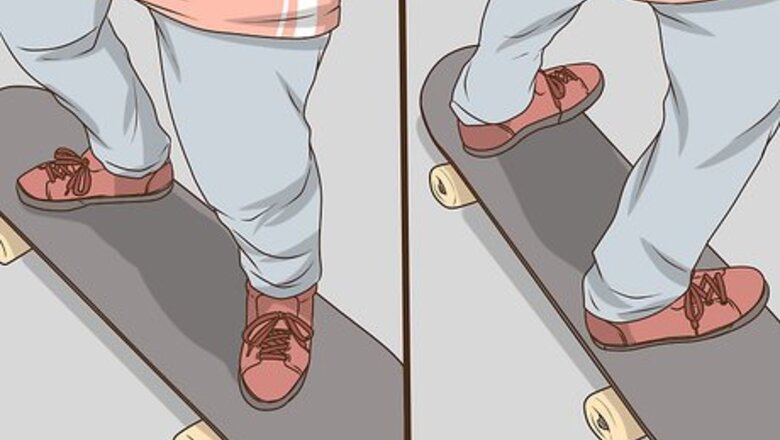
views
Finding a Comfortable Stance

Choose your stance—you can either ride "regular" or "goofy." In a regular stance, the left foot is situated at the front of the board, whereas in a goofy stance the right foot is up front. Determine which stance is more natural for you by considering whether you’re right or left handed. Most right handed skaters ride in a regular stance. In the end, you should do what feels most comfortable to you. Give both stances a shot and see which one you prefer. If you’re still not sure which stance is best for you, picture yourself on a moving skateboard approaching a ramp, about to bust out a gnarly trick. Which foot do you have forward? Whatever you imagined automatically is likely your most comfortable natural stance.

Keep your feet shoulder width apart. Start on flat ground; don’t worry about the skateboard at all right now. Place your feet directly under your shoulders and assume a natural stance. In this position, your weight should be evenly distributed over each leg. This will provide you with maximal balance and control over the board. Practice shifting your weight back and forth between each leg while keeping your body aligned and your head centered and upright. This will prepare you to settle into position of stability on the board.
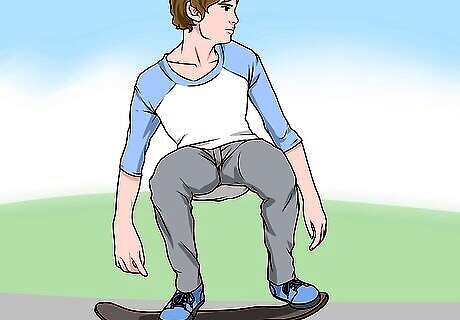
Bend your knees and sink your weight. Bring your butt down slightly and bend your knees a little. This will center your weight in your hips rather than higher up on your body the way it is when you’re standing normally. With a lower center of gravity, you’ll be less likely to come unbalanced once you’re on the unstable board. Loosen up. It’s harder to make corrections when you’re rigid. Don’t crouch or sink too deep. You just want to be low enough to create a solid base.
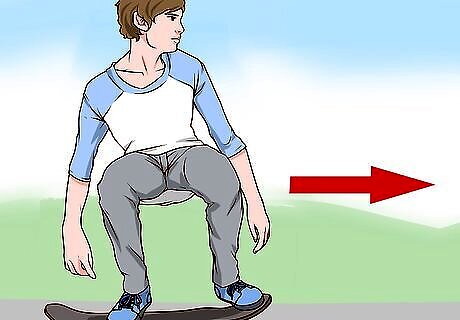
Point your head in the direction you’ll be moving. Turn your chin so that you’re facing the direction you would be going if the skateboard was in motion. If you favor a regular stance, this means you’ll be looking over your left shoulder; goofy riders will look to the right. You’ll be able to focus your sight on the ground ahead of you to spot obstacles and ready yourself for tricks, and the position of your feet will also fall within your peripheral vision. There’s a natural tendency to look down at your feet while you’re trying to keep your balance. Remember, however, that where your head goes, your body follows. Stay lined up and get used to looking a few feet ahead of the board.
Staying Balanced

Step onto the board carefully. Place one foot on the skateboard and make sure you’ve got solid footing. Then, quickly and cautiously lift the other foot and set it down beside your first foot. Your feet should be about shoulder width apart, the way you practiced. Once you’ve gotten on the board successfully, the hardest part is over! Don’t go too fast or too slow. If you hurry, you might cause the board to shift unintentionally. If you take too much time, you could throw yourself off balance standing on one leg. Aim to step up with an easy 1-2 pattern, with about the same pace that you would walk up stairs. You’re most likely going to fall a time or two as a beginner. Don’t let this discourage you. After you’ve taken a spill, your fear of falling will begin to fade and you’ll be able to better commit.
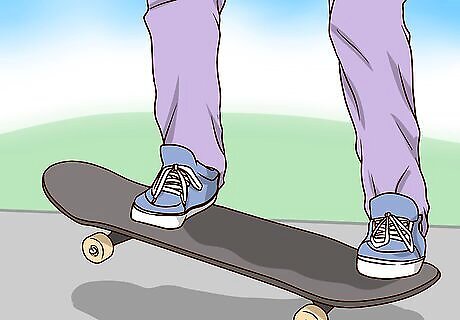
Position your feet over the trucks. A good rule of thumb when you’re first getting comfortable with standing on a skateboard is to stay centered over the trucks. The trucks are the long metal shafts on the underside of the board that attach the wheels to the deck (the wooden platform you stand on). Rest each foot over the bolts on the top of the board that hold the trucks in place. Don’t let your feet spread out too far or come together in too narrow a stance. Conveniently, the distance between the trucks is approximately the same as your feet when in a shoulder width stance.
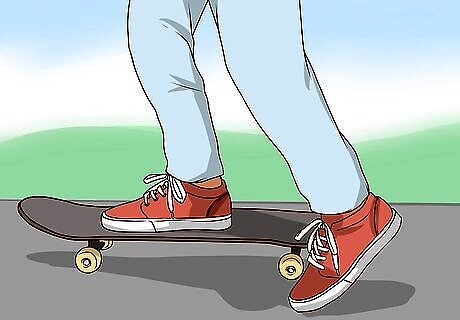
Keep your weight on the balls of your feet. Lean your weight forward slightly until you’re poised on the broad part of your foot directly behind the toes. When you’re skating, you need to be able to shift and reposition to stay balanced and perform different maneuvers. Staying on the balls of your feet makes it easier to lift, slide, and pivot your feet at will, and will also allow you to absorb shock through your lower leg muscles while you’re riding. Standing flat footed on a skateboard feels awkward because it essentially takes all agility out of the equation. When you’re on the balls of your feet, you’re ready to respond to the movements of the board. Raising up on tiptoe or letting your heels come off the board will also compromise your balance. Your entire foot should remain in contact with the top of the board; it’s just a matter of where your weight is directed.
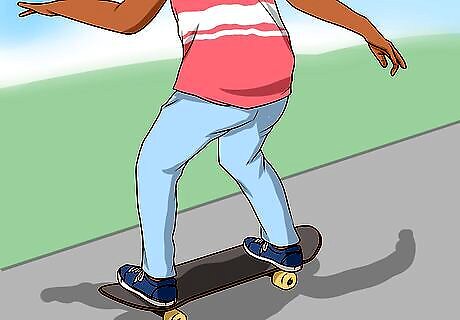
Make small adjustments. Use delicate movements of the feet, ankles, knees and hips to maintain your balance on the board. Lean, tilt, pump your legs and do whatever else you have to do in order to stay upright. You can even wave your arms to steady yourself, if it helps. You should constantly be making small adjustments to keep the board under control, especially once you’re in motion. It will continue to get easier the more you practice. If your feet and body are fixed in place, you will almost always come unbalanced. Try not to sway too far forward or backward. You might fall off or even tip the board over. Balancing on a skateboard is similar to standing on the deck of a boat that is rocking, pitching and swaying. It forces you to stay light on your feet.
Getting a Feel for the Board
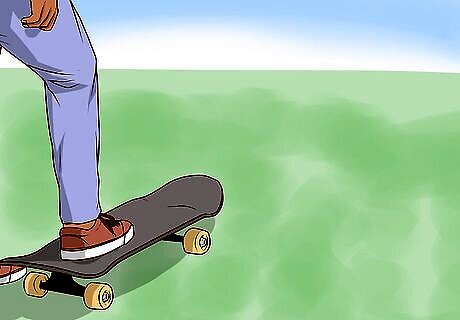
Start off on a soft surface. Set the board down in a patch of grass or on some thick carpet to make sure it doesn’t roll while you’re first learning how to stand on it. A softer surface will prevent the wheels from rolling and causing the board to come out from under you. Get comfortable balancing on the board somewhere stationary before graduating to the asphalt. You should ideally be fairly comfortable climbing on and off a skateboard that’s resting on carpet or grass before you attempt to move to a harder surface. Not only will soft terrain lock the board in place, it will also hurt less should you happen to fall.
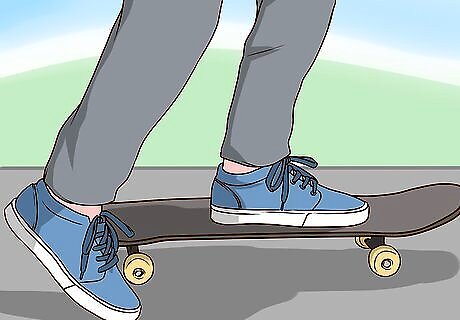
Be careful when putting your weight over the wheels. As you step up, do so one foot after the other in a quick, smooth, controlled manner. Beware of rocking the board too far in either direction. Since this is the same action that propels the board, you can easily lose your center of gravity and send the board, and yourself, flying. It can help to remind yourself not to lean too far in any direction when stepping up.
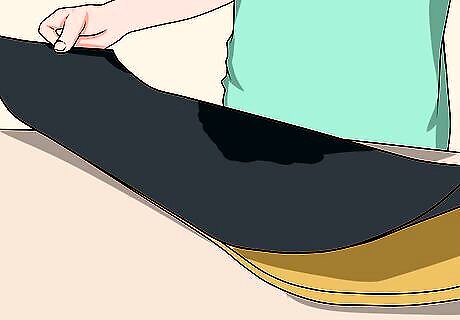
Use the grip tape for traction. Try getting the basics down on a skateboard that’s covered in a layer of grip tape. Grip tape is a type of adhesive surface similar to high-grit sandpaper that is designed to increase a skater’s traction. This added traction offers you greater control over the board. You’ll be able to progress at a faster rate if you don’t always have to worry about missing your footing. If you don’t have the benefit of grip tape, at least make sure you’re wearing grippy shoes and be extra aware of what you’re doing when you have to move your feet.
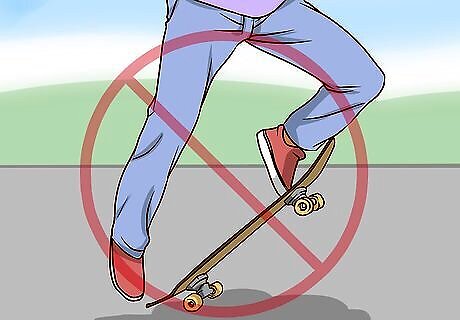
Avoid the tail and nose of the board. On either end of most types of skateboards there is an upturned edge known as either the “tail” or the “nose.” Leave these alone for now. Putting too much weight on the nose or tail will cause the board to lift up, raising one set of wheels off the ground. Needless to say, this can lead to a lot of accidents if it’s your first time on a skateboard. Ensuring that your feet stay over the bolts of the trucks is a good way to keep them from drifting toward either end. The nose and tail will come into play for more advanced tricks, like manuals, ollies and most other “pop” movements, that require you to manipulate the angle of the board.




















Comments
0 comment